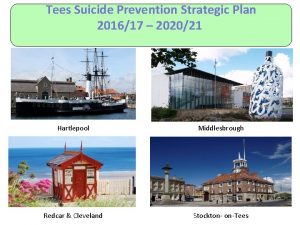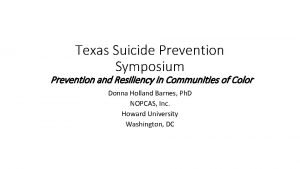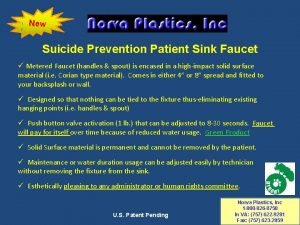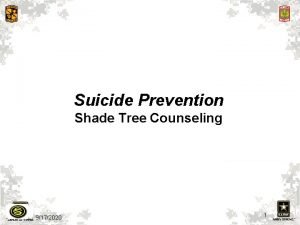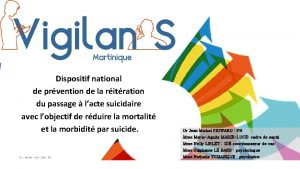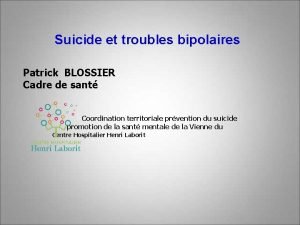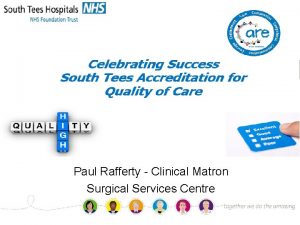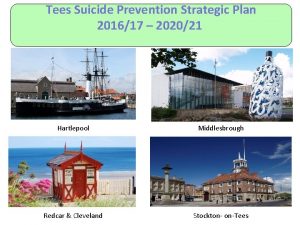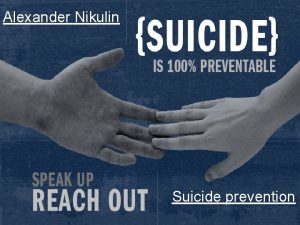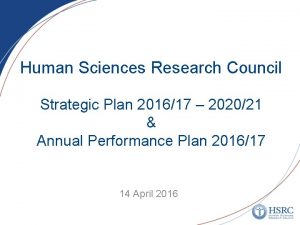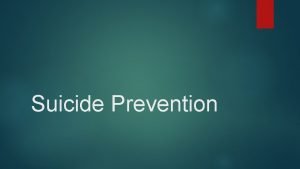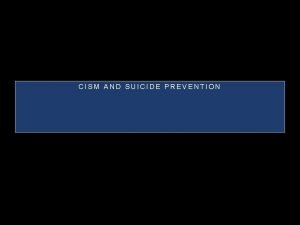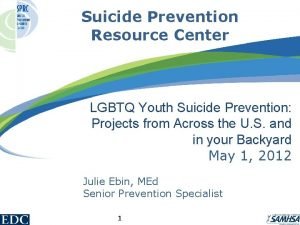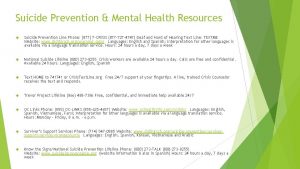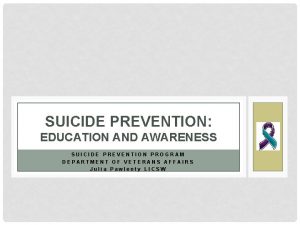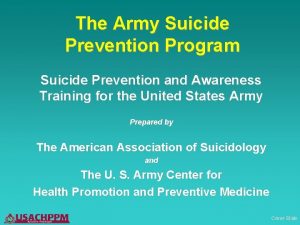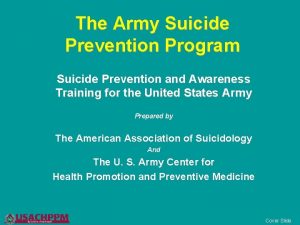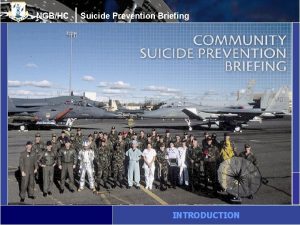Tees Suicide Prevention Strategic Plan 201617 202021 Hartlepool















- Slides: 15

Tees Suicide Prevention Strategic Plan 2016/17 – 2020/21 Hartlepool Middlesbrough Redcar & Cleveland Stockton- on-Tees

Foreword from the chair of the Tees Suicide Prevention Taskforce Suicides are not inevitable, in most cases they can be prevented. Suicide and non-fatal self-harm account for more than 4000 deaths and 200, 000 hospital presentations every year in England. Local audit across Tees shows that between 2013 -15 our region had higher age-standardised mortality rates from suicide per 100, 000 population than the England average: Rate per 100, 000 • = Value cannot be calculated as number of cases is too small Out of 14, 429 people who died by suicide in 2013 -15 in England – 10, 989 (76%) of those people were men, with suicide remaining one of the biggest killers for men under the age of 50. This trend is seen as well above locally in Tees with a higher proportion of suicide deaths in our region also being males under 50 years of age. Further details on the epidemiology for suicide and self harm across Tees is available through the joint strategic needs assessment (www. teesjsna. org. uk). Factors that lead to suicide are complex but nonetheless preventable. Preventing suicides requires multi-agency action as well as efforts at an individual, family, community and local authority level. The current economic climate and the welfare reforms present significant challenges for health and well-being in general and more specifically emotional well-being and mental health. The success of suicide prevention depends upon several inter-connected factors; leadership, targeted training, local champions, identification of suicide prevention as a priority, availability of resources and the long-term survival of suicide prevention groups. This implementation plan is the local response to the national suicide prevention strategy - Preventing suicide in England, A cross-government outcomes strategy to save lives launched in September 2012. It brings together, through the Tees suicide prevention taskforce, key partners, local knowledge about groups at higher risk of suicide, applying the evidence of most effective interventions and most importantly highlighting resources needed to implement these plans. Suicide and self harm prevention needs to be everyone’s business. I look forward to working with all key partners and continue to work towards preventing suicides and self harm across Teesside. Edward Kunonga Director of Public Health, Middlesbrough Council, Interim Director of Redcar & Cleveland Borough Council Chair – Tees Suicide Prevention Taskforce

Introduction Suicide is a major issue for our local population and a leading cause of years of life lost in Teesside. Nationally the number of people who take their own lives has been increasing in recent years. The England rate increased between 2006 -08 and 201315 from 9. 2 to 10. 1 deaths per 100, 000 population. In 2013 -15 the suicide rate was highest in the North East rising from 9. 9 in 2006 -08 to 12. 4 in 2013 -16 per 100, 000 population. Middlesbrough has the highest rate nationally with 17. 4 per 100, 000. The Five Year Forward View has set a national ambition to reduce the Suicide Rate in England by 10% by 2020/21. The average cost of suicide for those of working age in England is estimated to be around £ 1. 67 m per case (at 2009 prices). If this estimate is applied to the North East of England the projected cost to the local economy is £ 410. 8 million for the 246 cases of suicide and undetermined injury recorded in 2012. Suicide is often the end point of a complex pattern of risk factors and distressing events, and the prevention of suicide has to address this complexity. Suicides are not inevitable; indeed most are preventable (WHO 2004). There are many things that services, communities, individuals and society as a whole can do to help prevent suicide. Preventing suicide in England is a cross government outcomes based strategy produced in 2012 to help save lives and build on the work achieved by the last suicide prevention strategy. The local suicide prevention taskforce therefore seeks to drive local implementation of this new strategy and coordinate partnership working in Teesside and ensure that prevention is everyone’s business. From April 2013, local authorities became responsible for leading on local public health and improvement, which includes coordinating and implementing work on suicide prevention. The local suicide prevention taskforce is working on strengthening local partnerships and developing its own action plans focusing on how the national strategy action points are implemented in a way that reflects local population needs. In January 2016, the taskforce held a seminar for service providers across Teesside. The purpose of the seminar was to seek local input into the revision of the Tees Suicide Prevention Implementation Plan. The findings from that event will inform our local delivery

Preventing suicide in England; a cross-government outcomes strategy to save lives Preventing suicide in England; a cross government outcomes strategy to save lives is a national all age prevention strategy which aims to build on the successes of the earlier strategy published in 2002. The overall objectives of the National Strategy are: A reduction in the suicide rate in the general population in England; and better support for those bereaved or affected by suicide. The Strategy identifies six key areas for action to support delivery of these objectives: 1. Reduce the risk of suicide in key high-risk groups 2. Tailor approaches to improve mental health in specific groups 3. Reduce access to the means of suicide 4. Provide better information and support to those bereaved or affected by suicide 5. Support the media in delivering sensitive approaches to suicide and suicidal behaviour 6. Support research, data collection and monitoring.

Key Area for Action 1: Reduce the risk of suicide in key high-risk groups Some groups of people are known to be at higher risk of suicide than the general population. The high risk groups that have been identified nationally are: • Young middle aged men • People in the care of mental health services including inpatients • People with a history of self-harm • People in contact with the criminal justice system • Specific occupational groups such as doctors, nurses, veterinary workers and farmers What’s the current picture in Teesside? Across Teesside the highest number of suicides are among young men (aged 20 - 59). Compared to the national average of 1 female death for every 3 male deaths Teesside there is a ratio of 2. 8 male deaths for each female death. There are variations by local area and other high risk groups across Tees. The picture in Teesside reflects the national picture. The local audit of suicides in Tees also identified a higher percentage of suicides involved people who were not in employment and living alone. There is a disproportionate distribution of suicides across Teesside with more suicides occurring in people living in deprived compared to affluent wards. Further details are available on the JSNA website www. teesjsna. org. uk What are we going to do in Teesside? 1. 2. 3. 4. 5. 6. 7. 8. 9. Re-establish access to local suicide data and alert system Promote available services Explore the roll-out of the GP and Primary Care Suicide Prevention e-learning programme Respond to the Crisis Care Concordat Explore a localised approach to ‘talking down’ across agencies Encourage workplace policies that support mental health Support national, regional and local campaigns to challenge mental ill-health stigma and promote mental health Understand local need and appropriate response to selfharm Maintain and strengthen the Mental Health Tees Training Hub

Key Area for action 2: Tailor approaches to improve mental health in specific groups As well as targeting high-risk groups, another way to reduce suicide is to improve the mental health of the whole population. The approach to improve public mental health needs to be applied across the life course, starting from pre-birth all the way to the older age groups. It should include a blended approach that combines universal with targeted approaches especially for high risk and vulnerable groups. Across Teesside these groups include: • • • Children and young people known to mental health services Vulnerable children such as: looked after children, children in need, carers and those in the known to the Youth Justice Services Survivors of domestic and sexual abuse or violence Veterans and ex-service personnel People living with long term conditions People with untreated depression and other mental health conditions People who are especially vulnerable due to social and economic circumstances – unemployed, homeless People who misuse drugs or alcohol Lesbian, gay, bisexual and transgender (LGBT) Black and Minority Ethnic (BME) groups • • Asylum seekers and refugees Older people with social isolation People who have recently lost their jobs or businesses People recently bereaved – especially those bereaved by loosing a family member, friend, relative to suicide. What are we going to do in Teesside ? 1. GP Practices to complete the GP audit tool to capture data regarding any potential suicide. 2. Implement and support a range of preventative programmes to reduce the impact of the current economic crisis 3. Implement and support a range of preventative programmes to support the needs of specific groups (e. g. women in pregnancy; LGBT, Asylum Seekers etc)

Key Area for action 3: Reduce access to the means of suicide. One of the most effective ways to prevent suicide is to reduce access to high-lethality means of suicide. This is because people sometimes attempt suicide on impulse, and if the means are not easily available, or if they attempt suicide and survive, the suicidal impulse may pass. Suicide methods most amenable to intervention include: • Hanging and strangulation in psychiatric inpatient and Criminal Justice settings • Self-poisoning • Those at high risk locations • Those on the rail and underground networks The media also has an important role in avoiding reporting and portraying new high lethality methods of suicide that may increase the number of fatal attempts Local Suicide and Undetermined Injury Audit 2011 - 2013 Local audit shows that the majority of all deaths are by hanging with this method being used in 71% of all male deaths and 39% of all female deaths. Self poisoning was the method of death in 13% of all male deaths and 36% of all female deaths. Locally only in Middlesbrough between 2009 -2012 was there overall more self poisoning than hanging Local high risk locations: • Along River Tees including Bridges • Saltburn Cliffs (including Huntscliff) • Skinningrove Cliffs • Redcar Sea Front • Prison What are we going to do locally? 1. Identify local hotspots using suicide prevention audit and early alert system 2. Adopt the national Samaritans signage 3. Support the on-going work between the Samaritans, British Transport Police and Network Rail to reduce suicide on railways 4. Work with pharmacy leads to support safe prescribing and encourage the return of unused medication 5. Encourage local authority planning departments and developers to include suicide in health and safety considerations when designing structures

Key Area for action 4: Providing better information and support to those bereaved or affected by suicide Family and friends bereaved by a suicide are at increased risk of mental health and emotional problems and may be at higher risk of suicide themselves. Studies show that in addition to immediate family and friends, many others will be affected in some way. They include neighbours, school friends and work colleagues, but also people whose work brings them into contact with suicide – emergency and rescue workers, healthcare professionals, teachers, the police, faith leaders and witnesses to the incident. There may be a risk of suicide clusters or ‘copycat suicides’ in a community, particularly among young people, if another young person or a high-profile celebrity dies by suicide. Across Tees, bereavement featured as a contributing factor in 11. 7 % of suicide cases. Most of these cases had lost family members i. e. partner or parents, siblings or other relative. Half of these cases had been bereaved a year or more prior to death with less than five having been bereaved within the year leading to their death. In order to prevent suicide clusters or copycat suicides it is important that real time data is available to monitor local trends and ensure early intervention to prevent further cases. In Tees we will endeavour to re-establish an early alert system which will allow the suicide prevention taskforce to monitor patterns of suicide and instigate prevention and early intervention at the earliest opportunity. What are we going to do in Teesside ? 1. Explore the gap in provision for 0 -5 year olds 2. Manage performance of local support services for those bereaved or affected by suicide 3. Provide information of local, regional and national services/resources for those bereaved or affected by suicide

Key Area for action 5: Support the media in delivering sensitive approaches to suicide suicidal behaviour The media have a significant influence on behaviour and attitudes. There is already compelling evidence that media reporting and portrayals of suicide can lead to copycat behaviour, especially among young people and those already at risk. With the increasing popularity of social media more work needs to be done to make these safer especially for young people who can easily be influenced or affected by information communicated through these channels. Tees Local Authorities’ Communications Departments continue to support the media to deliver a sensitive approach to suicide and suicidal behaviour by: • Promoting the responsible reporting and portrayal of suicide and suicidal behaviour in the media • Continuing to support the internet industry to remove content that encourages suicide and provide ready access to suicide prevention services The national suicide prevention strategy encourages local services and agencies to work with their respective local and regional newspapers and other media outlets, to encourage responsible reporting of self harm, suicidal behaviour and suicide cases. This can be achieved by providing information on local sources of support and helplines for mental health, suicide and self harm when reporting incidents. What are we going to do locally? 1. 2. Review the taskforce communication strategy Promote the use of the Samaritan’s media guidelines for reporting suicide and self-harm 3. Promote positive promotional materials that • encourage help-seeking behaviour; • encourage support, understanding and recognition of those at risk • Promote access to services offering support 4. Offer support to schools to deliver training to students around media/online safety

Key Area for action 6: Support research, data collection and monitoring Intelligence and surveillance of suicides, self harm and mental health are the foundations of suicide prevention efforts. Further national and local research is required to address gaps in knowledge on self harm, suicidal behaviour and suicides. The national strategy outlines the following areas to support research, data collection and monitoring: • Build on the existing research evidence and other relevant sources of data on suicide and suicide prevention • Expand improve the systematic collection of and access to data on suicides • Monitor progress against the objectives of the national suicide prevention strategy • Reliable, timely and accurate suicide statistics are the cornerstone of any suicide prevention strategy and of tremendous public importance What is the situation on Teesside? More work is required to understand the epidemiology of self harm across Teesside. Whilst there a number of agencies that collect self harm data, further analysis is required to help inform targeted preventative action. Self harm related admissions in Tees are among some of the highest in England more work is required to understand the local picture in more detail and interventions put in place to address these issues. What are we going to do locally? 1. Utilise local academics to inform and learn from emerging research 2. Explore existing protocol to record and learn from attempted suicides 3. Re-establish the Tees Early Alert System.

Locality Health and Wellbeing Boards DPH DPH Stockton-on. Tees Borough Council Hartlepool Borough Council Middlesbrough Borough Council Redcar & Cleveland Borough Council Tees Suicide Prevention Taskforce Tees Suicide Prevention Partnership Network Locality Suicide Prevention JSNAs Tees Suicide Prevention Strategy Suicide Prevention governance arrangements across Middlesbrough, Hartlepool, Stockton-On-Tees and Redcar & Cleveland Please note: This strategy will be supported by an annual action plan which will be governed through the above structure


Suicide Prevention - Key Contacts SAMARITANS: Phone: 116 123 (24 hour helpline) Email: jo@samaritans. org Write to: Freepost RSRB-KKBY-CYJK, Chris, PO Box 9090, STIRLING, FK 8 2 SA www. samaritans. org. uk HOPELine. UK [PAPYRUS] Young suicide prevention society (under the age of 35) Phone: 0800 068 4141 (free from landlines 10 am – 10 pm weekdays, 2 pm – 10 pm weekends and 2 pm – 5 pm Bank Holidays). Text: 07786209697 Email: pat@papyrus-uk. org www. papyrus-uk. org Survivors of Bereavement by Suicide (SOBS) Helpline: 0300 1115065 (9 am to 9 pm daily) Web: www. uk-sobs. org. uk Email: sobs@support. hotmail. com Cruse Bereavement Care Helpline: 0808 8081677 Email: helpline@cruse. org. uk Web: www. cruse. org. uk Depression Alliance Web: www. depressionalliance. org Campaign Against Living Miserably [CALM] ). A campaign and charity set up to reduce the high suicide rate among young men (under 35). Helpline: 0800 585858 (free from landlines 5 pm – midnight daily) www. thecalmzone. net

Suicide Prevention – Local Contacts • Ring NHS 111 for urgent access to services - 24 hours a day, 365 days a year. • Contact your general practitioner (GP). If you do not have a GP or do not know your GP’s telephone number contact 111 or visit www. nhs. uk • Redcar & Cleveland People's Information Network (PIN) www. peoplesinfonet. org. uk • South Tees CCG IAPT Information http: //www. southteesccg. nhs. uk/about-us/mental-health-services/ • Hartlepool & Stockton CCG http: //www. hartlepoolandstocktonccg. nhs. uk/about-us/mental-health-services/ • Hartlepool Now http: //www. hartlepoolnow. co. uk/ • Stockton Information Directory http: //stocktoninformationdirectory. org/kb 5/stockton/directory/home. page • Middlesbrough Matters https: //www. middlesbroughmatters. co. uk/

Suicide Prevention – Local Contacts • Talking Therapies (IAPT) (non immediate risk of self harm/suicidal ideation) – self referral can be made via the website or a referral can be made via your GP at www. wecantalk. org • • GP Link Workers (Redcar only) – provide help with various social issues that may be impacting on your mental health https: //search 3. openobjects. com/mediamanager/redcar/fsd/files/main_gp_link_wkr_leaflet. pdf angela. garcia@redcar-cleveland@gov. uk debra. melville@redcar-cleveland. gov. uk • • Middlesbrough and Stockton Mind info@middlesbroughandstocktonmind. org. uk / http: //www. middlesbroughandstocktonmind. org. uk/ • • Redcar and Cleveland Mind info@rcmind. org / http: //www. rcmind. org/ • • Together Middlesbrough and Cleveland – Church group https: //www. cuf. org. uk/together-middlesbrough-cleveland • • Crisis Assessment Suite Roseberry Park, Marton Road, Middlesbrough, TS 4 3 AF
 Tees strategic plan
Tees strategic plan Primary prevention secondary prevention tertiary prevention
Primary prevention secondary prevention tertiary prevention Mad acronym suicide prevention
Mad acronym suicide prevention Glencoe health chapter 5
Glencoe health chapter 5 Suicide prevention chain teach
Suicide prevention chain teach Texas suicide prevention symposium
Texas suicide prevention symposium Suicide prevention sink
Suicide prevention sink Army suicide prevention situational questions
Army suicide prevention situational questions Prévention du suicide
Prévention du suicide Suicide prevention month quotes
Suicide prevention month quotes Army suicide prevention training
Army suicide prevention training Vivien blossier
Vivien blossier How are waterfalls formed
How are waterfalls formed Staqc meaning nhs
Staqc meaning nhs Tees lpc
Tees lpc Busted tees models
Busted tees models
